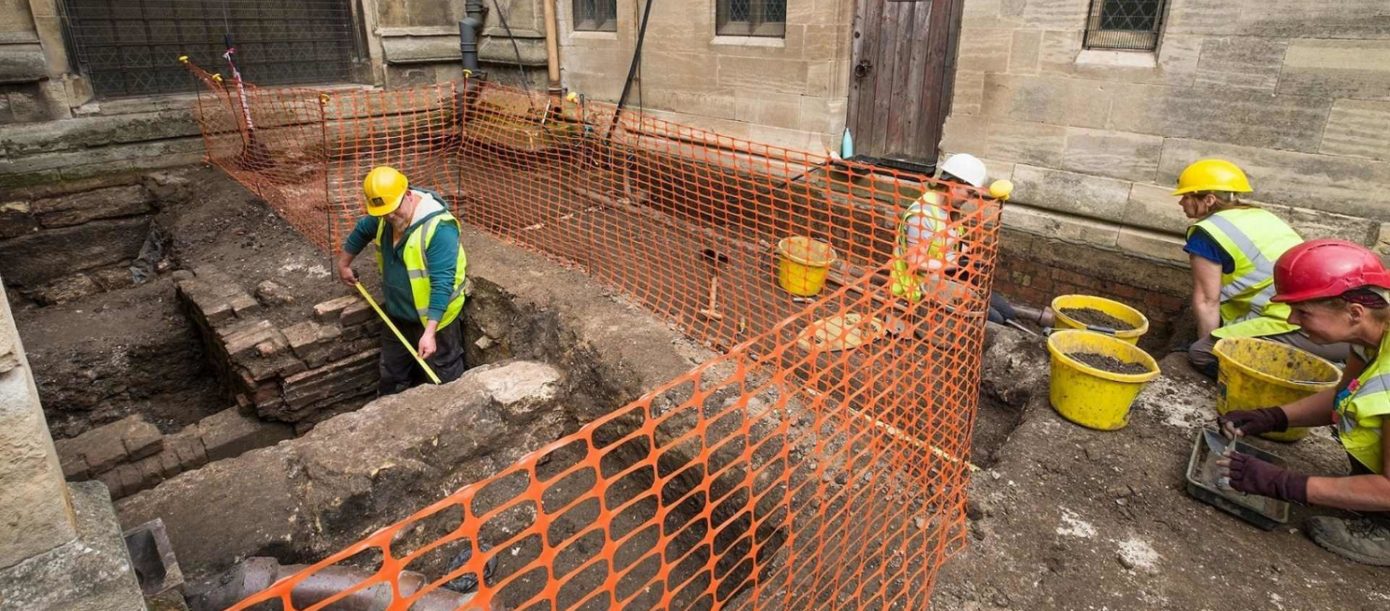Archaeology work has begun as the prelude to an exciting new extension to house a visitor and heritage centre at Hull’s historic Minster.
A £3.9m grant from Highways England is enabling Hull Minster to realise its ambitions to build the glass, bronze and stone extension on the 700-year-old church.
The extension will include exhibition spaces, a café and other new visitor facilities and will lead into a “heritage corridor” within the Minster, creating a home for carefully-curated exhibits about the history of Hull and the central role the church has played in it.
Now, a team from Humber Field Archaeology has started work to carefully excavate, record and reinter human remains into the Minster’s crypt, ensuring they are respectfully moved and not affected by any construction work for the new centre.
Over the coming months, the archaeology team is also planning to establish the extent of early structural remains on the site, including brick-built foundations, which were first discovered on the south side of the church in 2015 and could date back to the early 14th century.
The structural findings will also be meticulously recorded before construction of the centre begins, ensuring piling work does not affect the early foundations.
It is hoped the visitor and heritage centre will be complete and open to the public by mid-2021.
Bishop Frank White, Interim Minister at Hull Minster, said: “We are thrilled the archaeological work has now started and we are going to find out all kinds of things we didn’t know about the foundations of the Minster.
“I will be interested to see what the latest discoveries are and how they feature in the story of faith and life in the city. We are dealing with the history of people and we do that with respect and gratitude for everything we have inherited from the past.
“Everyone is very positive about the generosity of the grant from Highways England and the work we are able to do as a result of that, and there is a real buzz of anticipation around the change in this part of the city.
“The visitor and heritage centre will be a place for people to come and meet, view history and artefacts, and enjoy a fabulous space in the centre of Hull where people have been worshipping for 700 years.
“We believe people will be thrilled when they see what will be built here and how well it will blend with the Minster, as a contemporary space which is absolutely appropriate for the needs of the time we are living in.
“We want to do the best we can to enhance the community and reflect the glory of God.”
Announced earlier this year, the grant from the Highways England Environment Designated Fund is linked to the proposed A63 Castle Street scheme, which passes just 100 metres from the Minster. This major project is designed to improve access between the Port of Hull and the national road network via the city centre.
The grant has been awarded to the Hull Minster Development Trust, which has led the transformation of the Minster over recent years to enable it to host flexible and inclusive forms of worship and a wide range of social, cultural and community events.
The fund is designed to protect historic features in areas near to major roads, helping them to be harmonious with their surroundings, and will enable the completion of the Minster’s £4.5m development project and much more.
As well as the visitor and heritage centre, the improvements will include an education and learning centre, disabled access ramps and accessible toilets, a modern electrical system, and a community garden providing homegrown fruit and vegetables for the café. The changes will safeguard the Minster’s heritage for future generations, creating a sustainable future for the church as a place of worship, focal point for the community and magnet for visitors.
Ken Steedman, Project Manager at Humber Field Archaeology, said the team was expected to be on site for 16 weeks.
He said trial excavations carried out on the south side of the church in 2015 had encountered a number of substantial brick-built foundations representing an early and previously unknown phase of the church, probably dating to the early 14th century. Archaeologists also recorded fragments of a grave marker from the 13th or 14th centuries.
He added: “The present work provides an extraordinary opportunity to further examine these early structures and to more fully establish their date, survival and extent, with the potential to contribute a great deal to knowledge of the history and development of this important church, a Grade I listed building of national significance.”
Matthew Armitage, Highways England Project Manager, said he hoped the grant would help the Minster build on its growing success as hub for the community, venue for cultural and social events and visitor destination.
He said: “The great thing about our Designated Fund programme is that we can grant money for projects outside of our traditional schemes, helping protect historic features in areas near to our major roads.
“It’s now been around year since we were first got involved in the Minster’s development project and it’s really exciting to see archaeological work underway.
“The grant for Hull Minster will transform the church and I think people will be very excited by what they see at the church in the future.”






































































































